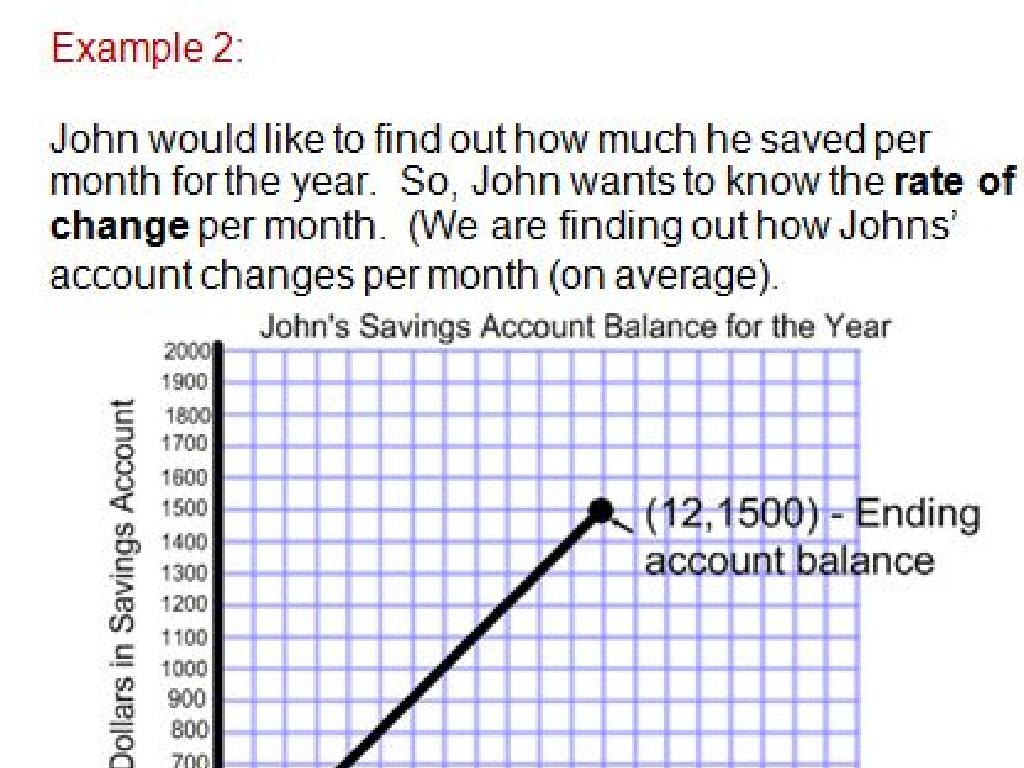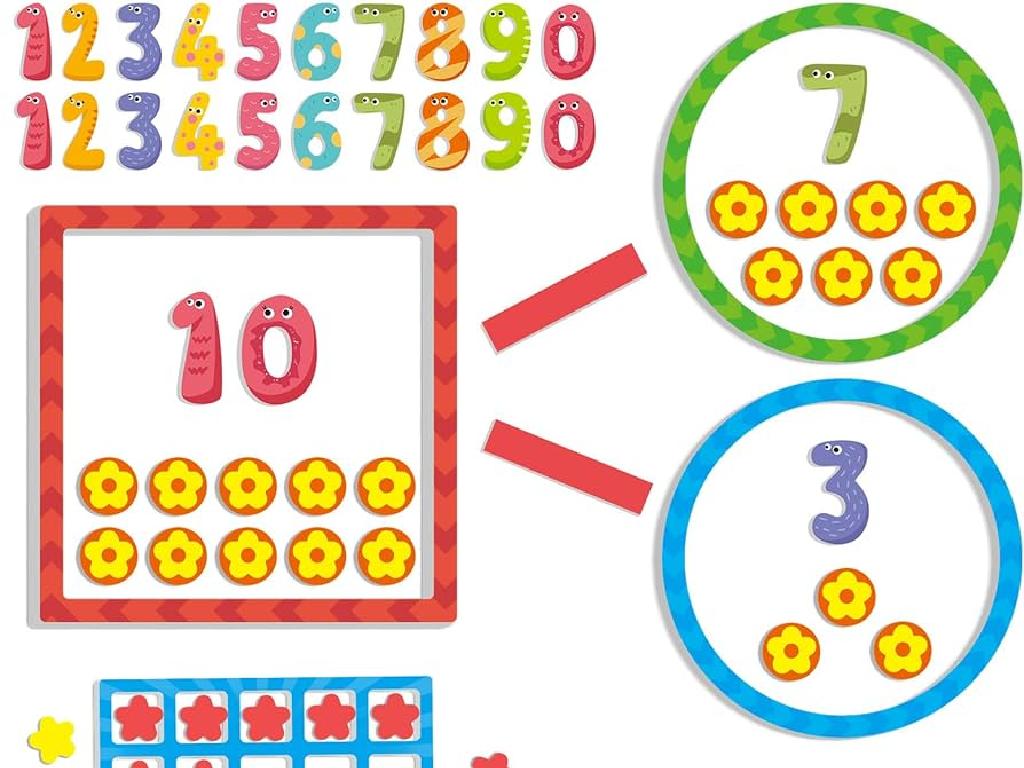Identify Independent And Dependent Variables
Subject: Math
Grade: Seventh grade
Topic: Two-Variable Equations
Please LOG IN to download the presentation. Access is available to registered users only.
View More Content
Understanding Variables in Equations
– Define variables in equations
– Variables represent numbers in equations, e.g., x and y in 2x + 3y = 6
– Independent vs. dependent variables
– Independent variable is chosen (e.g., x), dependent variable (e.g., y) relies on it
– Significance of variable roles
– Knowing which is which helps solve equations and understand relationships
– Examples to illustrate differences
– If x is time spent studying and y is test score, y depends on x
|
This slide introduces the concept of variables within the context of two-variable equations, focusing on the distinction between independent and dependent variables. Emphasize that variables are symbols that stand in for unknown values and can change. The independent variable is the one we have control over or choose, and the dependent variable is what we measure or observe changing in response to the independent variable. Understanding the difference is crucial for solving equations and interpreting data in graphs or experiments. Provide examples to solidify the concept, such as the relationship between hours studied (independent) and test scores (dependent), where the score is affected by the amount of study time.
Understanding Variables in Equations
– Define a variable in math
– A symbol that stands for a number we don’t know yet
– Variables in simple equations
– For example, in x + 2 = 6, x is the variable
– Variables as numbers or quantities
– They can represent things like age, distance, or money
– Practice identifying variables
|
This slide introduces the concept of variables, which are fundamental in understanding algebra and two-variable equations. A variable is a symbol, often a letter, that represents a number or quantity whose value is not yet known. In simple equations, variables are used to show relationships between numbers and to solve problems. For instance, in the equation x + 2 = 6, x is the variable that represents the unknown number we are trying to find. Variables can stand for any number and are used to represent real-world quantities such as age, distance, or money. Encourage students to practice identifying variables in different equations and to understand how they are used to describe various situations.
Understanding Variables in Equations
– Define independent variables
– The variable you change to see its effects, like time spent studying.
– Define dependent variables
– The variable affected by the independent, like test scores.
– Relationship between variables
– How one variable responds to changes in the other.
– Impact of variable changes
|
This slide aims to clarify the concepts of independent and dependent variables within the context of two-variable equations. The independent variable is the one that is changed or controlled in an experiment to test the effects on the dependent variable. For example, in a study scenario, the amount of time spent studying (independent variable) can affect the scores on a test (dependent variable). It’s crucial for students to understand that the dependent variable is what is being measured or tested, and it ‘depends’ on the independent variable. Discuss how changes in the independent variable can lead to changes in the dependent variable, and vice versa, using real-life examples that are relatable to seventh graders. Encourage students to think of their own examples and understand the cause-effect relationship between the two types of variables.
Identifying Variables in Equations
– Find the manipulated variable
– The independent variable is what we change
– Recognize the responsive variable
– The dependent variable is the result of the change
– Practice with sample equations
– Look at equations and determine the independent and dependent variables
– Understand variable relationships
|
This slide is aimed at helping students understand the concept of independent and dependent variables within the context of two-variable equations. The independent variable is the one that is changed or controlled in an experiment, while the dependent variable is the one that is tested and measured. It’s crucial for students to be able to identify these variables as it lays the foundation for understanding how to set up and interpret experiments and data. In class, provide examples of equations and ask students to identify the variables. Encourage them to explain why they think one is independent and the other is dependent. This will not only help them grasp the concept but also apply it in practical scenarios.
Real-Life Variables in Two-Variable Equations
– Temperature vs. Ice Cream Sales
– As temperature increases, ice cream sales may rise.
– Study Time vs. Test Scores
– More study time can lead to better test scores.
– Exercise: Craft Your Example
– Think of a scenario where one variable depends on another.
|
This slide aims to illustrate the concept of independent and dependent variables through relatable examples. The first example shows how ice cream sales (dependent variable) may increase with higher temperatures (independent variable). The second example demonstrates that test scores (dependent variable) can improve with increased study time (independent variable). For the exercise, encourage students to come up with their own real-life scenarios where one variable affects another. This activity will help solidify their understanding of the relationship between independent and dependent variables. Provide guidance on how to identify which variable is independent and which is dependent in their examples.
Graphing Independent and Dependent Variables
– Plotting variables on graphs
– X-axis: Independent Variable
– The variable that stands alone and isn’t changed by other variables you are trying to measure.
– Y-axis: Dependent Variable
– The variable that depends on other factors, particularly the independent variable.
– Interpreting two-variable graphs
– Understand how the variables relate and the impact of one on the other.
|
This slide introduces students to the concept of graphing independent and dependent variables within two-variable equations. Emphasize the importance of correctly plotting variables, with the independent variable on the x-axis and the dependent variable on the y-axis. Explain that the independent variable is the one that is manipulated or controlled in an experiment, while the dependent variable is what is being measured or tested. Interpreting graphs is crucial for understanding the relationship between the two variables. Provide examples of simple experiments or scenarios where identifying and graphing these variables would be necessary. Encourage students to think of their own examples and consider what would be the independent and dependent variables in those cases.
Class Activity: Variable Hunt
– Pair up for a variable search
– Find classroom independent variables
– Objects or factors that can be changed
– Discuss variable relationships
– How does changing one affect the other?
– Present findings to the class
|
This activity is designed to help students apply their understanding of independent and dependent variables in a real-world context. Have the students pair up and look around the classroom to identify various objects or scenarios that could represent independent variables (things that can be changed or controlled) and their corresponding dependent variables (results or outcomes that depend on the independent variables). Encourage them to think critically about how changing one variable might affect the other. After the discussion, each pair will present their examples to the class, explaining their reasoning. This will not only reinforce the concept but also enhance their public speaking skills. Possible examples: the volume of music (independent) and student concentration (dependent), the number of lights on (independent) and visibility in the room (dependent).
Conclusion: Variables in Equations & Homework
– Recap: Independent vs Dependent
– Importance of identifying variables
Understanding variables is crucial for solving two-variable equations effectively.
– Homework: Analyze a news article
Choose any recent article related to science, economics, etc.
– Identify variables within the article
Determine the independent and dependent variables in the study or report.
|
As we wrap up today’s lesson, remember that independent variables are the ones you change to see the effect on dependent variables, which are the outcomes you measure. Grasping this concept is vital for solving equations, as it helps you set up and solve for unknowns. For homework, find a news article that includes a study or report with data. Identify the independent and dependent variables discussed. This will help you understand how variables interact in real-world situations and enhance your critical thinking skills. Be prepared to discuss how you determined the variables in our next class.





